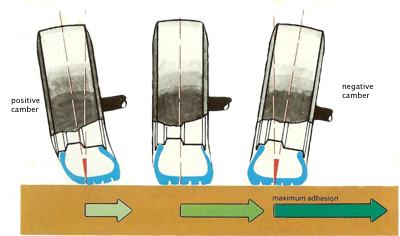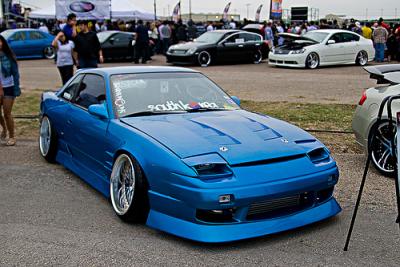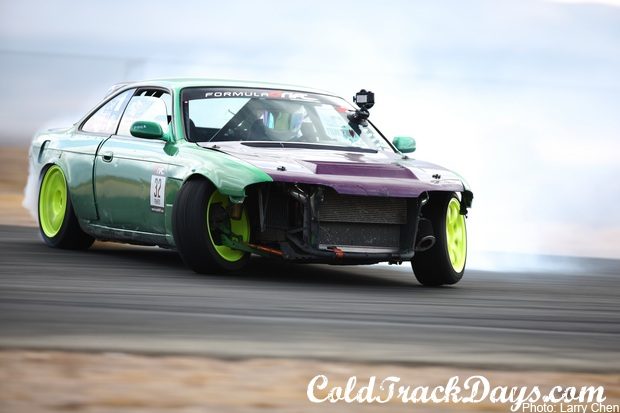- 2,187

- Kansas City
- PsuPepperoni
NOTE: As of 1.09, Camber effects have changed, but I'll wait for more people to test it out before posting any results.
When a wheel has negative camber, the outside of the tire leans slightly off the ground.
In a straight line, this creates a smaller contact patch and lowers the tires' potential to accelerate and decelerate the vehicle.
During hard cornering, sidewall flex will cause the contact patch to roll flat onto the road and, ideally, create the largest possible contact patch and improve grip.

Note that this only works for the outside wheel, but since the car will lean onto the outside wheels while cornering, that's where you want to maximize grip.
The sweet spot for camber depends on the strength of the sidewalls.
There is a limit of course. Extreme camber means that the sidewall will never flex enough to level out the tread with the road surface, and you end up with a tiny contact patch on the inside corner of the tire. Some drifters do this to their wheels to make them slippery. They also stretch tires onto wider wheels, which angles the sidewalls and makes them more resistant to lateral flex, negating any extra grip that the camber would have added

On a perfectly balanced car, increased camber on the front wheels should allow the front of the car to take tighter turns than the rear. When taken to the limit, the rear end will lose traction first and centrifugal momentum will cause it to slide towards the outside of the curve and rotate the vehicle too quickly.
Increased camber on the rear wheels causes the front wheels to reach the limit first, which means loss of steering and inability to rotate the car through the corner. Centrifugal momentum carries the car on a tangent line until the front wheels regain traction.
Interesting note from Wikipedia about interaction between toe and camber:
"When a wheel is set up to have some camber angle, the interaction between the tire and road surface causes the wheel to tend to want to roll in a curve, as if it were part of a conical surface (camber thrust). This tendency to turn increases the rolling resistance as well as increasing tire wear. A small degree of toe (toe-out for negative camber, toe-in for positive camber) will cancel this turning tendency, reducing wear and rolling resistance. On some competition vehicles such as go-karts, especially where power is extremely limited and is highly regulated by the rules of the sport, these effects can become very significant in terms of competitiveness and performance."
When a wheel has negative camber, the outside of the tire leans slightly off the ground.
In a straight line, this creates a smaller contact patch and lowers the tires' potential to accelerate and decelerate the vehicle.
During hard cornering, sidewall flex will cause the contact patch to roll flat onto the road and, ideally, create the largest possible contact patch and improve grip.

Note that this only works for the outside wheel, but since the car will lean onto the outside wheels while cornering, that's where you want to maximize grip.
The sweet spot for camber depends on the strength of the sidewalls.
There is a limit of course. Extreme camber means that the sidewall will never flex enough to level out the tread with the road surface, and you end up with a tiny contact patch on the inside corner of the tire. Some drifters do this to their wheels to make them slippery. They also stretch tires onto wider wheels, which angles the sidewalls and makes them more resistant to lateral flex, negating any extra grip that the camber would have added

On a perfectly balanced car, increased camber on the front wheels should allow the front of the car to take tighter turns than the rear. When taken to the limit, the rear end will lose traction first and centrifugal momentum will cause it to slide towards the outside of the curve and rotate the vehicle too quickly.
Increased camber on the rear wheels causes the front wheels to reach the limit first, which means loss of steering and inability to rotate the car through the corner. Centrifugal momentum carries the car on a tangent line until the front wheels regain traction.
Interesting note from Wikipedia about interaction between toe and camber:
"When a wheel is set up to have some camber angle, the interaction between the tire and road surface causes the wheel to tend to want to roll in a curve, as if it were part of a conical surface (camber thrust). This tendency to turn increases the rolling resistance as well as increasing tire wear. A small degree of toe (toe-out for negative camber, toe-in for positive camber) will cancel this turning tendency, reducing wear and rolling resistance. On some competition vehicles such as go-karts, especially where power is extremely limited and is highly regulated by the rules of the sport, these effects can become very significant in terms of competitiveness and performance."
Last edited:






